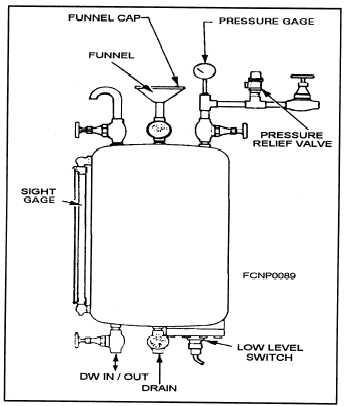EXPANSION TANKS
Expansion tanks may be either gravity tanks or
pressurized tanks. The expansion tank serves a three-
fold purpose in a liquid-cooling system. First, it main-
tains a positive pressure required on the circulating
pump inlet for proper operation of the circulating
pump. Second, it compensates for changes in the cool-
ant volume because of temperature changes. Third, it
vents air from the system and provides a source of
makeup coolant to compensate for minor losses due to
leakage or losses that occur during the replacement of
radar equipment served by the system. Refer to fig-
ures 2-6 and 2-7 as you study this section.
When an expansion tank is used as a gravity tank,
it is located above the highest point in the distilled-
water system. This provides sufficient pressure to the
suction side of the circulating pump. It also ensures a
flow of water from the tank into the system when
makeup water is required.
The tank is provided with a sight glass to check
the level of water in the tank. The sight glass should
normally show the tank to be from two-thirds to
four-fifths full. The glass should be redlined at four-
fifths of the tank capacity. A vent pipe is located on
the top of the tank to prevent air pressure from build-
ing up in the system. A valve and funnel connection
with a cap are located on the top of the tank to provide
a means for filling the system with distilled water. A
low-level alarm switch is usually set at 20 percent of
tank capacity.
When the fluid level in the tank lowers to 20 per-
cent of the full level, visual and audible alarms actuate
at the alarm switchboard to warn personnel that the
system is low on distilled water. If the tank runs out of
water, air is drawn into the system, which results in
increased corrective maintenance on the system to
remove the trapped air or possible pump damage and/
or failure of high-power transmitter components.
The pressurized expansion tank is normally lo-
cated near the circulating pump suction in the return
main of the secondary liquid-cooling system. The
pressurized tank is airtight and is charged with com-
Figure 2-6.—Gravity expansion tank.
Figure 2-7.—Pressure expansion tank.
2-9



